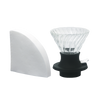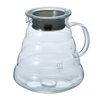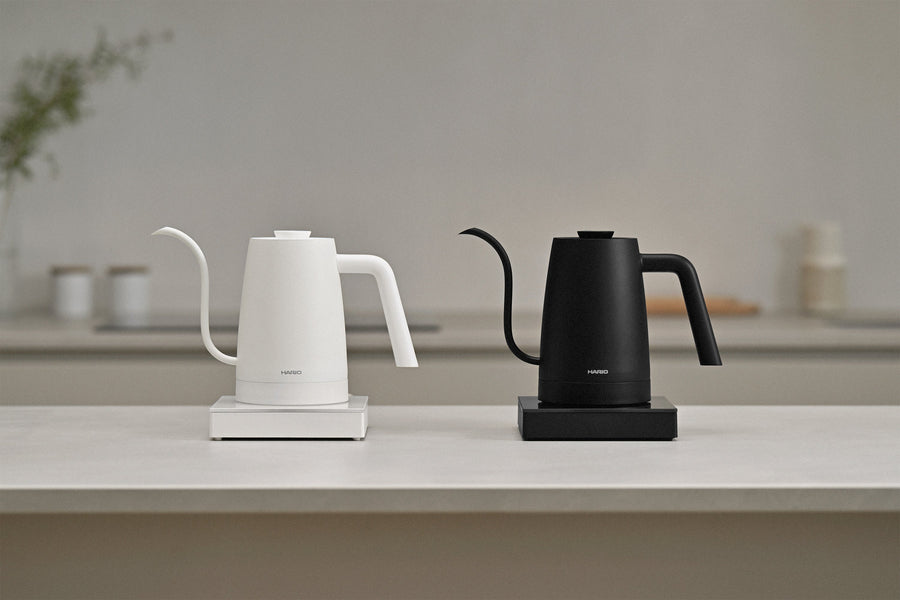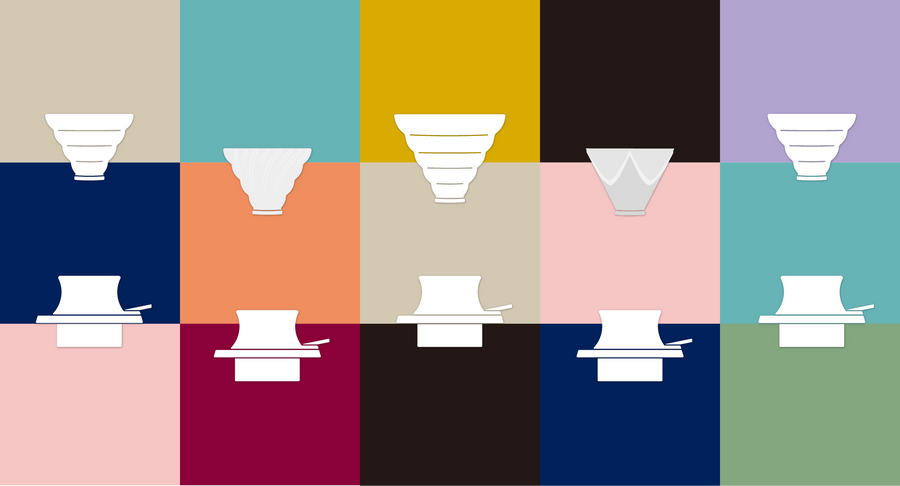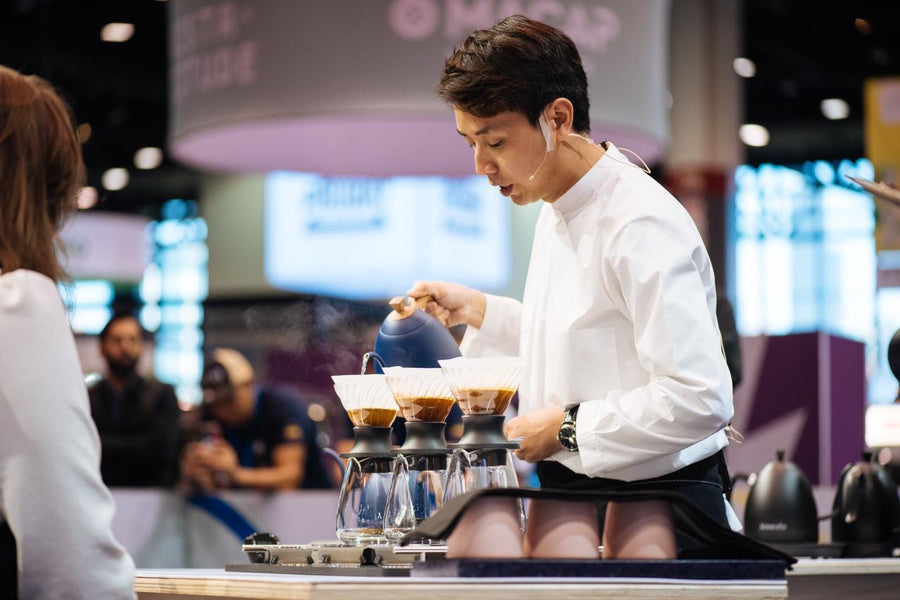Born and raised in Norway, Ole Kristian Bøen recently represented Norway in the 2021 World Brewers Cup in Italy, using a HARIO Switch as his dripper of choice. We recently had the opportunity to sit down with the 2020 Norwegian Brewers Cup Champion to discuss coffee, competitions and… cycling!
When we call Ole, he is sitting in a meeting room at his workplace in Drammen, southwest of Oslo, where he works for a real estate developer. Despite what some may assume when they hear that he is the national champion, Ole has actually never worked in the coffee industry. His love for the drink made him more and more curious over the years, prompting him to start visiting a lot of coffee shops and talking to the baristas there. (His work in Oslo meant that he was surrounded by great cafes). Finally he tried his hand at brewing filter coffee himself with his first dripper: a glass V60.
“After I got the V60 at home, I was curious to see how it works. It was interesting to see how the [taste of the] coffee changed by adjusting the different parameters, like grind size, water temperature, ratio, etcetera. The coffee tasted so much better than from a machine, with quite simple steps. I think the first recipe I learned was the Tetsu Kasuya recipe, and the coffee just tasted so much better.” At home, Ole only brews filter coffee as he doesn’t own an espresso machine. “I make some four to six brews per day, changing up the brewing methods.”
Starting out in specialty coffee
While for some, the sometimes subtle differences to the various parameters may make the world of specialty coffee seem daunting, Ole doesn’t see it that way. “A lot of my friends also think that filter coffee is complicated, but it shouldn’t be. It should be for everyone. You don’t need [a lot of complicated] equipment to do it [and] there are so many friendly people you can ask for advice. That’s what I tell all my friends: it’s not complicated if you’re curious how it works. I really believe everyone can make great filter coffee at home.”
To Ole, the variables in different brewing methods are what make specialty coffee so fascinating and, contrary to what people might think, easy for beginners, as it allows for a lot of experimentation. “But,” he adds, “if you just brew the same recipe every day, you don’t learn everything.” When he teaches someone how to brew coffee, they usually start off thinking hand brewing is complicated. “But then I show them and they think, ‘oh, it’s easy! I can do this at home.’”
So what is Ole’s advice to people who are interested in specialty coffee, but unsure where to start? “Try different things, but try it one at a time. If you change one thing, don’t change the rest. So only change the water temperature, or only the grind size or only the [water/coffee] ratio. Change one thing and see how it works. That’s really important.”
Something that can be a challenge for people starting out is the sheer amount of information online, which can sometimes be overwhelming. “There are so many brewing methods, so many recipes, that it seems very complicated when you look at it from the outside. And I think that that’s not a good thing for the industry. A lot of roasteries and makers and such make a bit of an unnecessary fuss [about specific coffee characteristics or parameters] for marketing purposes, but I think that may actually scare some people away.”
While the last year and a half of global pandemic lockdowns has been rough, to say the least, for the coffee community, there is at least a slight silver lining in that more and more people have discovered home brewing. “Hopefully people will continue to [brew at home] after Covid. There are a lot of great roasters in Norway, so people should try them out. Try out different roasts, ask for different products and try different recipes.”

Ole using the HARIO Switch during a qualification round for the Norwegian Brewers Cup in 2020.
(Photo courtesy of Ole Kristian Bøen)
Joining competitions
After brewing at home, Ole decided to join a regional coffee competition in Oslo in 2018. “I just grabbed a bag of coffee from my local coffee shop and joined the competition. As I didn’t read the rules, it didn’t go very well, but it was really fun. I met [2015 World Brewers Cup Champion] Odd-Steinar Tøllefsen there, and he was so friendly. He gave me advice and let me taste his coffee.” Ole was quite surprised by the friendliness and openness of the world champion, as well as the coffee community in general, citing it as the reason he really got into competitions. “I used to do competitive cycling, and in that world, you don’t really share everything with your competitors. The edges are a bit sharper, if you will. It’s not the same as in the coffee industry.”
Cycling, it turns out, was actually one of the catalysts for his interest in coffee. “Coffee is a part of the cycling culture. When you go for a long, five-hour ride, you always stop for coffee on the way.”
When asked how he fits coffee competitions, a full-time job in digital marketing for a real estate developer, as well as cycling into his schedule, he mentions that he also skis (“You have to like winter sports when you live in Norway!”), is married and has a two-year-old daughter.*
“It’s a challenge to fit everything into my schedule. Especially practising for the [2021] World Brewers Cup in Milan. I booked the meeting room at my office for half an hour for lunch every day in the two months leading up to the 2021 World Brewers Cup, coming up here every day and recording myself brewing coffee.”
* His tip for parents: “Include the kids in the brewing process. My daughter loves grinding coffee, putting the filters in the drippers, and so on.”

Cycling was a catalyst for Ole's love for coffee.
(Photo courtesy of Ole Kristian Bøen)
The 2021 World Brewers Cup and the HARIO Switch
After joining several competitions, Ole participated in and – to his own surprise – won the 2020 Norwegian National Brewers Cup. “I was just brewing coffee at home, so I didn’t expect to win. So that was fun!” The national competition was the last big coffee event before the lockdown started in Norway, but after a long year and a half, the careful re-openings around the world allowed for the World Brewers Cup to be held in Milan (Italy) in October 2021. Being the Norwegian champion, Ole was invited to participate in the competition. When it came to choosing which dripper to use in the championship, he turned to one of HARIO’s new drippers: the Switch.
“I was introduced to the Switch through Kaffa in Oslo, just after it was released [circa January 2020].” It was the unique combination of percolation and immersion offered by the dripper that made it an eye-opener for him. “I think it’s much easier to brew difficult coffees with the Switch. Many competition coffees can be difficult to brew in a regular V60, because they’re heavily processed. In my daily routine, when I brew a washed Ethiopia [for example], I normally go with a V60, but when I brew a more funky or fermented coffee, like a Geisha, I always go for the Switch. I’ve actually never had a bad experience with a Switch, especially for complex coffees.”
That settled the dripper selection, but what about the coffee beans to be used in the open service part of the World Brewers Cup competition? While he had initially ordered a coffee from abroad, it got stuck in customs and didn’t arrive in time. Instead, he ended up using a natural processed Geisha coffee from Hacienda La Esmeralda in Panama.
“Kaffa Oslo had this beautiful [coffee], which I tested and loved. That was two or three weeks before Milan. The challenge was that it was already roasted and ready, so we didn’t have any other roasts to try. So that was it. I had only 700 grams.” The beans were actually a mix of two different farms from Esmeralda, one of them really sweet, and the other with a nice acidity. This made mixing them together work really well, especially with the percolation and immersion capabilities of the Switch.
NB: You can find Ole's 2021 World Brewers Cup recipe here!

Ole using the HARIO Switch drippers at the 2021 World Brewers Cup in Milan, Italy.
(Photo credit: Specialty Pal for the Specialty Coffee Association)
The meaning of coffee
Speaking of Geisha coffee… The best cup of coffee he ever had was when he tried a Geisha from Ethiopia for the first time. “I was planning my wedding with my wife, and we visited the local coffee shop in my hometown. I had the bag of coffee, and at the time, I didn’t want to brew it myself, because I was afraid of ruining it. So I just gave it to the woman at the café, and she brewed it. I didn’t know it was possible for coffee to taste so good.”
Although he very much enjoys participating in coffee competitions, he isn’t looking to go into coffee full-time anytime soon. “Never say never, but coffee is hard work. It’s not easy to earn the money you need for a family. But I definitely will be in the competition environment, and try to win again. Let’s see what the future brings!”
So, what is it that makes him invest so much of his free time and effort in coffee? What does coffee mean to him? When asked that question, he replies: “It’s so much. It’s the thing that wakes me up in the morning; the thing that pushes me for more knowledge… And it’s also friendship.” A really important reason for doing competitions is that he was able to make so many friends through it, all around the world. “It’s connections. That’s the thing that drives me in the industry and keeps me doing this, keeping me awake at night and training for competitions, because I want to have more of those connections.”
The fact that Ole became the national champion and the Norwegian representative at the World Brewers Cup, despite never having worked in the coffee industry, and also having a full-time job as well as a family life, just goes to show that brewing good coffee isn’t something that only full-time, professional baristas can do; good coffee is within reach for everyone who is interested in it. As long as you enjoy coffee and want to learn more, you can make a world-class cup of coffee right in your own kitchen. “I really recommend everyone who is interested [in specialty coffee] like I was, to just sign up for a competition. Because you meet so many good friends and learn so much from it.” With a smile, he adds: “Just sign up and make sure to read the rules.”

Ole competing with HARIO Switch drippers in the finale of the Norwegian Brewers Cup in 2020.
(Photo credit: Liv-Yuan Reinsviki)
Where to find Ole
Ole can be found on Instagram, where he is busy making more connections. “If people have questions about competitions, I’m happy to answer. That’s a fun thing after Milan. I got so many messages from people around the world who watched my routine or asked about my recipe. That’s what I normally do!” he laughs.
Speaking of recipes... Ole was kind enough to share with us the recipe that he used in Italy at the 2021 World Brewers Cup, so you can try it out for yourself! You can find it right here.
Header photo credit: Specialty Pal for the Specialty Coffee Association

